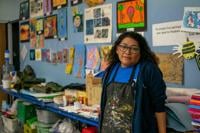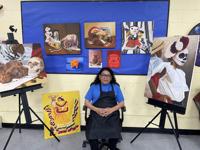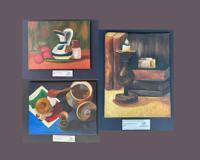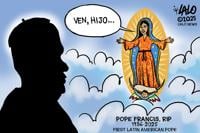Hard work and dreams. These are two things Sandra Tovar always kept in mind when she arrived in the United States at age 18. Like any other immigrant family, Tovar came to the U.S. looking for a better life and explained that when she was with her family, she felt like she had everything she needed in life. Until the person she admired the most, her dad, passed away three months later. Tovar continued on with her life, working various side jobs such as babysitting or working in a factory, until life put her in the path of the Boys and Girls Club. She originally started as a volunteer at a Long Beach location, and it was through that experience that Tovar learned to learn about others without judging them.
“Even though my limitation with language was very strong, they were still able to welcome me and embrace me without discrimination,” Tovar said.
Tovar became aware of the importance of educating others about finding their identities, and realized that it was okay to be Brown and have an accent. She recalled the only instance where she felt like she couldn’t express herself was due to the surrounding adults encouraging her to lie low and to avoid being noticed. Although there were instances when Tovar felt different, growing up in a family that celebrated everything and was full of tradition, it was strange for her to see her peers go through these cultural identity problems when she first arrived in the United States.
After her dad passed away, Tovar kept a promise she had made to him that she would do her best and be a successful person. She began to educate herself and later got the opportunity to volunteer at the Boys and Girls Club. It was only then that the Boys and Girls Club saw Tovar’s ability to create and offered her the position of an art instructor. Today, Tovar is the Fine Arts Director of the Boys and Girls Club of the Los Angeles Harbor. She credits her opportunity as being very lucky in life and has been with the organization for nearly 20 years.
“She already comes with a plan on what to do; for January it was Chinese New Year, February was Black History Month, and for March we’re doing International Women’s Day. So every month she has something going on,” site coordinator Norma Salceda said.
CALÓ NEWS interviewed Sandra Tovar recently to learn more about her life and how she serves as a role model for aspiring Latino artists.
Responses have edited for clarity and brevity.
SANDRA TOVAR, 53, FINE ARTS DIRECTOR, SHE/HER, MEXICAN

sandra tovar
Sitting in between one of her many oil paintings, Sandra Tovar dedicates these art pieces to honor her heritage, tradition and identity. Photo courtesy of Sandra Tovar.
HOW DID YOU GET STARTED IN ART?
As I was growing up, I found refuge in my drawings, but they were awful. I always wanted to draw cartoons I felt connected with. Like any kid, I wanted to draw Disney characters or anything I saw on TV, but I couldn’t because nobody taught me how. The only one who saw something in me was my dad. He was the first one to give me my first drawing pad and my first Prismacolor set. I will never forget it, and I have never found another set exactly like that. So I started drawing, but I felt like it was allowing me to create something and to feel free without being judged.
As time passed, I developed a passion for it. I was going to school in Mexico, and for three years they didn’t ask me; they just threw me into architectural drawing. So I took classes to become an engineer or architect. I learned the techniques, which I was so upset and mad about because they were so strict, but thanks to that, I gained knowledge of the basics of drawing. When I came to the United States, I totally forgot about it because I came here to work and to be reunited with my family. But then, when I started working at the Boys and Girls Club, I knew that the ability to draw was exactly what I needed for what I was hired to do, basic arts and crafts. I started gaining knowledge of art, fine arts and cultural enrichment, but it has been a long journey for me. It was like going to school without going to school, learning without teachers for all these years. I’ve been teaching myself everything until 2014 when I was able to take art classes for the first time.
HOW HAVE YOU IMPLEMENTED ANY LATINO CULTURE INTO YOUR PROGRAM?
Every day, I’m always sure that they know who we are and our history. That there are more Latino artists, not only from Mexico. There is a project that I’m proud to say I started with the help of other co-workers, and you are the first one that I’m going to talk to about this with the public. I created something that I call Exploring Latin American Through Art, ELATA, because I saw the need to promote our traditions, our culture, and who we are.
I’d say we are more than tacos. Just the fact that there is so much beauty in every country in Latin America, even in the Caribbean. So I started myself, I took the decision to explore America, but also the Latino community. And I gave the class, once a week, and I was able to start investigating different artists. But I always look for others who have given back to their country.
One huge celebration that it has been part of the community is Dia de los Muertos. It started very small, just for the club, then we took it into the parking lot outside, and now we close the street, and invite the community. And last year, we were so honored that we got the attention from the Boys and Girls Club of America, that they stayed the whole day with us.
HOW HAS IT BEEN WORKING WITH THE BOYS AND GIRLS CLUB FOR MANY YEARS? HOW HAVE THEY ALLOWED YOU TO EXPRESS YOURSELF?
I’m so lucky; you just have no idea! The only thing that I can tell you is that when you do things with honesty and are true to yourself, people can see that. I’m never going to forget something that Antonio Prieto, the Regional Director now for the San Pedro region, said. When I got transferred to his site, I was going to go into it being thankful like others. But he told me, “Sandra, this is your place, look at it as a canvas. Do whatever you want!”
Honestly, in my mind, he just gave me freedom, and until today, I can proudly say that I have built the art program from the ground up. I have established a fine arts program here; I provide monthly trainings, in which I give ideas, techniques, and lesson plans for all grade levels. Right now I oversee 20 people, and there’s going to be more soon because we’re growing. I’m proud to say this is a longtime dream.
WHAT WERE SOME TEACHINGS YOU WERE TAUGHT BEFORE THAT YOU IMPLEMENT NOW INTO YOUR WORK?
We make lesson plans. We do arts and crafts, I talk to the kids, and we have the ability to be bilingual here, so we don’t lose the language, as we have members that only speak Spanish. So it’s funny because sometimes I find myself in the same class talking back and forth between English and Spanish. I got to accommodate the kids that speak Spanish, and they are just newcomers, so that way we don’t lose our language. Even if they don’t speak it really well, they know it and won’t lose it.

Sandra Tovar art
This collage features artwork from Tovar’s classes, exploring graphite, charcoal, ink, acrylic and oil paintings. Tovar said these students applied painting techniques in order to understand the importance of the elements and principles of art. Collage by Erick Cabrera. Photos courtesy of Sandra Tovar
ARE THERE ANY LATINO ARTISTS THAT YOU LOOK UP TO AND ARE INSPIRED BY? WHY?
Oh, my goodness! Someone who has inspired me in art is Diego Rivera, as an artist and not as a person. With a focus on his art, he always expresses himself, regardless of whether he gets into trouble. He found his technique among his own people. When he became friends with Picasso and other artists during his time, he realized that his technique and style were unique to his country. He came back and found his style within his country by taking those walks to see these farmers markets and flower vendors. When he saw these ladies selling flowers, that’s when he got inspired. That’s why he has this distinct style of technique, and he honors that with his people. I always feel proud when I see Latino artists. Regardless, when I go to museums and see a Latino name, even if they don’t show the full name, it inspires me because I can see that it’s possible.
WHAT ADVICE WOULD YOU GIVE TO OTHER LATINOS WORKING IN THE ARTS?
Be true to yourself and never give up. Don’t try to be somebody else. Whether it’s how you paint, the way you take pictures, or whichever art you are into, it’ll be okay. There are going to be more people on your path who will question you, and say that you’re crazy and no one is going to care about you, compared to people who will tell you to keep going. Stick with those people; even if it’s just yourself who tells you to get up, go to work, and keep going. What you are doing is worth it and one day you will see it pay off.
















(0) comments
Welcome to the discussion.
Log In
Keep it Clean. Please avoid obscene, vulgar, lewd, racist or sexually-oriented language.
PLEASE TURN OFF YOUR CAPS LOCK.
Don't Threaten. Threats of harming another person will not be tolerated.
Be Truthful. Don't knowingly lie about anyone or anything.
Be Nice. No racism, sexism or any sort of -ism that is degrading to another person.
Be Proactive. Use the 'Report' link on each comment to let us know of abusive posts.
Share with Us. We'd love to hear eyewitness accounts, the history behind an article.